- Home
- Rudy Rucker
Jim and the Flims Page 2
Jim and the Flims Read online
Page 2
People were actually eating the gene-tweaked eel flesh, going, like, “Hmm, this is tasty.” By the time the meat was about half gone I was drunk and stoned enough to announce what it was.
“We eat what we grow!” I whooped, and let out what I considered to be a Texas-style yodel.
Some of the engineers thought I was funny—but the execs and the staff were majorly pissed. Not that eating the tweaked eel would actually be bad for you. Your stomach acids break down all the DNA you eat—it doesn’t go and crawl into your cell nuclei. But, still...
Nobody went public with the story of my misdeed, but word got around. From then on, I was pretty much blackballed from the biotech biz. I’d phone up for an interview, and I’d hear the receptionist fighting back a laugh.
I got a pretty good severance package from Wiggler. For awhile I had some hopes of striking out on my own—I still had my vague notion of finding a better mental model language for the process of genetic engineering. And if my theorizing didn’t lead anywhere, maybe I could get into designing lab equipment. One of the few things I’d inherited from my Dad was a workshop’s worth of tools.
The house I’d rented in Cruz was a granny cottage in the back yard of a biggish stucco home on Madrone Street. My house faced the alley. My landlords were a Dick and Diane Simly. Dick owned a high-end car dealership called Simly The Best. The lot was switching over to hybrids and electrics, so Dick and Diane drove a pair of gas-guzzler Jaguars that Dick hadn’t been able to sell. Somehow Dick had made a profit by keeping these two cars—the guy always came out ahead.
Generally speaking, Dick and Diane left me alone. And when I adopted a puppy from the pound to keep me company, they didn’t squawk. My dog’s name was Droog—he was a collie-beagle mix. He liked to follow me around the house, watching everything I did. It was almost like I had an assistant.
Working on the screened-in side porch of my cottage, I built a scanning-tunneling microscope of my own—you call it an STM for short. I found the design on the web, and the parts only cost me about a thousand dollars. Why did I build an STM? Well, I still had some dreams of making a genomics breakthrough on my own—or of managing to patent a new wrinkle on the lab hardware.
Basically an STM works by bringing a tiny sharp tip close to a sample that’s resting on a little sample sled. You run voltage into the tip and the sample, and you track the virtual current that seems to flow across the gap. A computer munges the data and turns it into a display that resembles a bumpy surface—with the bumps being individual atoms. Even better, you can use your scanning tip to manipulate the individual atoms.
Obviously it’s important to have a very narrow scanning tip in your STM. For my home-built machine, I was using slivers of tungsten needles whose tips were only one or two atoms thick, just like we’d been doing at Wiggler Labs. I began wondering if there might be a way to find some better kind of scanning tip. If I could come up with that, maybe I’d have a way of getting better STM images, and that could lead to something marketable.
One afternoon, gnarly, funky Skeeves happened to come walking down the alley by my house. He didn’t seem to be looking for me; I think he was just wandering around. I was feeling bored and lonely, so I called out to him, gave him a beer, and showed him some of the pictures I’d been making with the STM.
“This is a hair,” I told Skeeves, flipping through the images on my computer. “This is a grain of pollen. And here’s an ant’s mandibles.”
“Ant,” said Skeeves, studying my computer screen. He reminded me of a dog trying to read. “Ants have hair? Can you see an atom?”
“Yeah, yeah. When I worked at the biotech lab, we were getting pictures of DNA. But those are pretty fuzzy.”
“Which part makes it sharp?” asked Skeeves, running his long, shaky fingers over my scanning-tunneling microscope’s boxes and wires.
“The scanning tip,” I said, pointing out how it slid back and forth above the samples. I went on to tell Skeeves about my quest for the sharpest needle ever. Not that he seemed to be listening to me. As if paralyzed by boredom, he lolled back in his chair, staring up at the corner of the ceiling like someone else’s voice was coming from up there. Soon thereafter, he’d finished his beer and left.
A week later, Chang showed up at my house.
“I’ve got something for you,” he said, taking out a little matchbox.
“Dope?”
“Sure,” said Chang. “But what’s in this box is a weird little prong of exotic matter that Ira stole from the lab. A tip for your whatchamacallit. Your microscope thing.”
“Ira?”
“You know him,” said Chang. “Little guy? Gnarly surf punk? Gay? Has a crush on Skeeves? He works nights as a janitor in the UC Santa Cruz labs.”
Chang handed me the box and I looked inside. The new tip was the shape of a toothpick, and at the sharp end, it cusped out into a point that was impossible to see.
“Ira gave you this for my STM?”
“Sold it to me,” said Chang. “For a bag of pot. Which you’ll have to pay for. Skeeves told Ira you needed a sharper tip. I guess he heard that from you?”
“Uh, yeah, I saw Skeeves not too long ago. But it didn’t seem like he even understood what I was saying.”
Chang laughed. “The way Skeeves works is that he remembers what he sees and hears and then he talks it over with the woman’s voice he hears in his head. He’s still living in his van with that casket with the mummies, you understand. And he talks to the spirit of the woman mummy that he fucks. He’s let me see the sarcophagus up close—though he won’t let me look inside. The box is all gold and covered with those wiggly Egyptian diagrams. Thousands of years old, according to our man.”
“Why isn’t Skeeves in jail? Or in the nut house?”
“He has this knack for falling between the cracks,” said Chang, shaking his head. “Beneath notice. Beyond belief.”
“And you’re saying that Skeeves told Ira to find me a better tip for my STM?”
“What it is, brah. Skeeves’s mummy woman’s soul hipped him to your trip.”
Again I had that feeling of reality being a laminate of layers—and that some of the layers were flaking off.
“Okay,” I said. “I’ll pay for Ira’s pot.”
I asked around a little, and found out that Ira’s tip was a stiff whisker of metallic hydrogen. One of the UC physics profs had had found a way to keep the stuff stable at room temperature. And Ira had stolen a random scrap that just happened to have the shape I needed.
The tip’s narrow end was, I initially thought, a single row of protons. But now, thinking back on where that tip led me, I’d say that it must have incorporated a unique quantum anomaly. I think it must have contained an infinitely thin cusp of warped space. Going a little further out on the edge, I’d go so far as to speculate that the soul of Skeeves’s mummy woman had done some special tweaks on that tip.
But, to start with, all I knew was that Ira’s scrap of metallic hydrogen was very sharp. And, so far as I could find out, the physics prof wasn’t thinking at all about scanning-tunneling microscope tips. So for a couple of weeks I was hoping I might have lucked into a new and patentable technological process.
But, to my disappointment, my metallic hydrogen tip didn’t work any better than the carbon nanotubes that the big labs were using. Although my new scans were cleaner than they’d been with the tungsten tip, they weren’t any sharper than the carbon nanotube pictures that I could find online. And in any case, it didn’t seem like a realistic business model to base a product on metallic hydrogen tips that a janitor friend of a friend was stealing from a lab.
So, okay, my STM was really just a hobby, a science toy. I wasn’t going to find any patentable new process here. And I wasn’t really going to be using my STM for any independent biotech research. Truth be told, I’d come to think of bioengineering as slow, boring and, yes, potentially evil.
By now my severance pay had run out and I needed a job. Lacking any bet
ter ideas, I got a job as mailman working out of the Santa Cruz post office. In a way, I’d always wanted to be a mailman. It’s a clear-cut social good. Nobody ever comes up and tells you that delivering mail is evil. And I liked going out to walk the streets every day. By now, my dog Droog was well-behaved enough that I could leave him home alone.
3: Val
I started noticing a certain woman my age on my mail route. She shared a house with a couple of other people, and most afternoons she’d be out in front reading, or tending to her cactus plants.
“Nice shorts,” she said to me one day, commenting on my postal uniform. “And, hi, I’m Val.”
“I’m Jim. I like your cactuses.”
“Succulents. I’ve been collecting samples from other people’s yards. I break off a couple of leaves, or a sprout, and I stick them into the dirt. They like to grow.” Val smiled at me. She had nice eyes, green with flecks of brown. And shiny brown hair. “How did you end up being a mailman?”
“I got a degree in bioengineering at the UC,” I said, setting down my mail bag. “And I had a job in a lab, but it didn’t pan out. Not everyone gets my sense of humor. And recently I was doing a little research on my own. But now I’m delivering mail.”
“You tweaked genes?” said Val. “Isn’t that bad?”
“It might be,” I said. “If we ever got good at it. At this point, it’s like we’re trying to program a computer by hitting it with a hammer. When I started, I thought I’d be helping people to decorate themselves with tentacles instead of tattoos. Or that I’d grow myself an extra dick.”
“There’s something wrong with your first one?” said Val pertly.
“Lately I haven’t checked,” I said, studying her. “I live alone with my dog.”
Val was vivacious and cute, with a playful curve to her lips.
“What?” she said as I continued gazing at her.
I gathered my courage. “Would you want to go out tomorrow night? We could get some food and see a punk show.”
“Not a regular punk show,” said Val.“Zonked sweaty boys elbowing me. Maybe the women’s roller derby? That’s punk, too, a little bit. I know some of the women who skate.”
“That’d be perfect,” I said. “Just so I’m with you.”
“Deliver the mail!” said Val, acknowledging the compliment.
“How come you’re always at home?” I asked, wanting to keep the conversation going. “Are you a grad student?”
“I’m a kindergarten teacher,” said Val, drawing herself up and giving me a stern stare.
“I’ll sit on my mat. I’ll eat my slice of apple.”
“That’s good, Jim.” She went back to being a pretty girl in her yard. “I have a short work-day. It’s nice.”
We started seeing each other a lot. Val didn’t seem like a teacher at all—she liked to dance, she joked about sex, and sometimes she’d smoke pot with me. Not that we partied all that much. I’d cleaned up somewhat after my Wiggler flame-out.
I loved talking with this woman. Even more than the things she said, I liked the music of her voice. Our conversations were like opera duets, where the rich, vibrant tones matter as much as the specific words. Val was naturally good-humored, always ready for fun. And my dog loved her.
Our romance took its course. Val moved in with me, and we got married.
Finally my life was on the right track. Val and I were, like, California-style salt of the earth: a kindergarten teacher who grew cactuses, and a mailman who dabbled in high-tech research. I liked how low-stress it was being a mailman.
Val and I spent a lot of time just hanging around our little pink cottage, being comfortable. Other times we’d go on road trips, camping near the sea, bringing Droog on the trips. We even started to talk about having a baby.
I became more and more removed from biotech. If I could enjoy life being happy with Val, that was enough. Even so, I was still playing with my scanning-tunneling microscope a little bit. It was cool to be able to see stuff all the way down at the atomic level.
“I have something to show you,” I told Val one night after supper. “My favorite molecule.”
It was February, with a fairly powerful rainstorm outside. Droog was asleep on his cushion by the heating vent. I’d worn a slicker and boots to deliver the mail that day, and had gotten wet just the same. Dear Val had greeted me with a nice pot of lentil soup.
“Where does your molecule live?” asked Val, her face warm in the candlelight. We liked having little romantic dinners, complete with candles and wine.
“The molecule’s a she,” I said. “I call her V. She’s on the porch.”
“Inside your junk pile?”
“That’s it. Come on.”
My STM was a small mound of random-looking tech equipment. I had a computer with a big-screen display, a binocular optical microscope for bringing the STM’s tip close to the sample sled, a set of piezoceramic widgets for moving the tip, and an electrical transformer that smelled of ozone.
The rain was picking up, with water flowing down the window panes in wavy sheets. The dark palms were whipping back and forth, and thunder boomed across the sea.
“Lightning!” said Val, glancing out the window, her eyes soft and dark. “It’s like you’re the mad scientist in his laboratory.”
“Just where I’ve always wanted to be,” I said. “With a beautiful wife to care for me. I’m glad our roof doesn’t leak.”
“We wouldn’t want your pet molecule, V, to get wet.” She giggled and perched herself on the beat-up old armchair we kept out here.
I cranked up the scanning-tunneling microscope, and the transformer made just the kind of rising whine that you’d expect from a science-fiction lab. I checked the positioning of the sample, then threw the switch that engaged the piezoceramic manipulators. They made a nice clicking sound. I set them to sweeping Ira’s metallic hydrogen tip back and forth across the sample surface. An image began developing on my computer screen, an archipelago of dots.
“What is this molecule?” asked Val.
“It’s you! I took skin flakes from your hairbrush, extracted some DNA, and fixed one of the strands to a graphite plate. See how shapely you are?”
We could see a blurry double helix, coiled around like a kelp stalk on the beach.
“Oh, don’t tell me you want to tweak my genes!” protested Val. “Ugh.”
“Just admiring them for now,” I said. “We’ll use the old-school method for any tweaks.”
“Tonight might be a good time to try,” she said softly.
I went over to her and gave her a kiss. And then we were in bed, making love. It definitely added some spice to know we were doing it for real. Unprotected. Hoping to make a baby. I felt an odd tingle in my spine.
Just as we came, lightning struck a power pole across the street. It was a strange moment—for an instant I couldn’t tell if the lightning was out in the world or inside my body. The lights in our house went out, and the scanning-tunneling microscope on the porch made a popping noise that was lost in the astonishing clap of thunder.
For a second or two, Val and I lay there stunned and half-deaf. Droog was whining in the kitchen. A siren sounded in the distance. In the velvety darkness, I seemed to see a glowing yellowish dot come zigzagging into our room. A tiny shape seemed to wriggle at the center of the dot.
Val cried out. The orb homed in on us and disappeared in the tangle of our bedding.
“Did something just now crawl inside me?” exclaimed Val, her voice rising. She sat up, throwing back the sheets. “I swear I felt a tingle down there—what’s going on, Jim! Help!”
I fumbled for the matches on the nightstand and got a candle going. My hands were shaking.
Beautiful naked Val was next to me, her eyes big and wet. Seeing her made everything seem safe.
“It’s okay,” I told her, putting my arms around her.
“But I saw something flying towards us,” insisted Val. “Like a bug.”
“A ligh
tning bug,” I said, trying to joke. “It was just an afterimage. From the flash. Nothing crawled inside you. No way.” I gave her belly a gentle pat. “Nothing in there but you and me.”
Val peered down at herself and let out a shuddery sigh. She managed a little smile. “What a story for the baby. If this was the time.”
A fire truck rumbled into our street with its radio going. The rain was still pouring down. We could see a charred utility pole and some sparking wires. We put on our robes, got some cookies from the kitchen, and stood by the window watching, with Droog at our feet. The firemen put up barriers around the live wires and left.
Before returning to bed, I looked in on my scanning-tunneling microscope—it had blown a heavy spark, charring the sample on its little sled. The metallic hydrogen tip had shattered into a little stub. I turned off all the power switches and set the sample sled on a corner of my desk.
The next day I figured out that the power surge had shorted out something in the STM—but I didn’t get around to fixing it. The sample sled stayed there on my desk where I’d put it.
Winter turned to spring. Green sorrel sprouted all over the back yard. And one day Val had some news for me when I came home from work. As soon as I walked in, I could see it on her happy face.
“You saw the doctor?” I asked.
“We’re expecting!” she sang. “It’s gonna happen. Oh, wow, Jim, do we have to start being grown-ups?”
“Never,” I said. “We’ll be the cool kind of parents.”
“How will we know what to do?”
“You’ve got a head start,” I said. “From teaching kindergarten.”
“I hope I’m not one of those mothers who’s always reasoning with her baby,” said Val. “Loudly so everyone around can hear. Because, because, if and then.”
“The baby,” I said, trying out the word.
“Baby, baby, baby,” echoed Val. “That’s such a funny word. It sounds chubby and cute.”
“Mama Val. I like it.”
It was a hard pregnancy. Val was hungry all the time, but she threw up a lot, too. She’d fill a plate with food, then stare at it in disgust. And she was having nightmares—but she didn’t want to tell me what they were about.

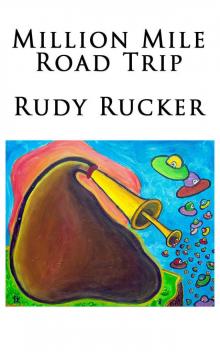 Million Mile Road Trip
Million Mile Road Trip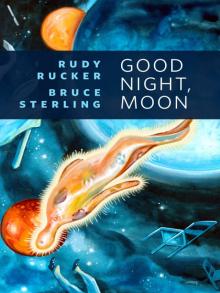 Good Night, Moon
Good Night, Moon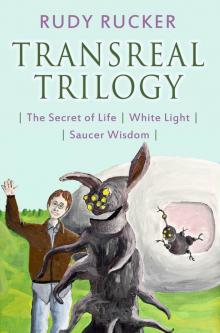 Transreal Trilogy: Secret of Life, White Light, Saucer Wisdom
Transreal Trilogy: Secret of Life, White Light, Saucer Wisdom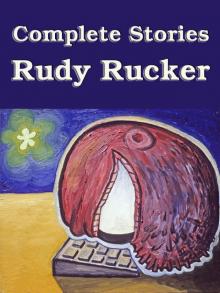 Complete Stories
Complete Stories The Sex Sphere
The Sex Sphere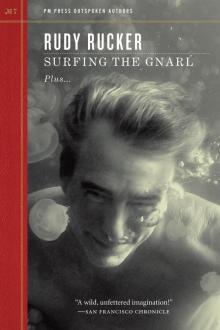 Surfing the Gnarl
Surfing the Gnarl Software
Software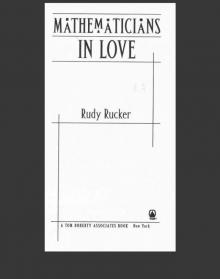 Mathematicians in Love
Mathematicians in Love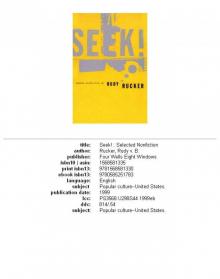 Seek!: Selected Nonfiction
Seek!: Selected Nonfiction The Secret of Life
The Secret of Life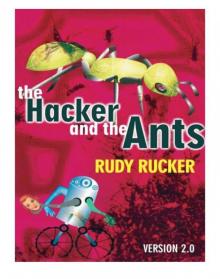 The Hacker and the Ants
The Hacker and the Ants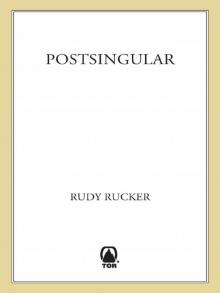 Postsingular
Postsingular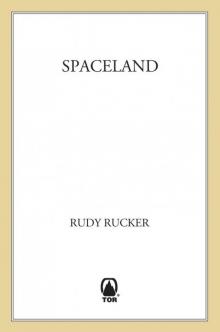 Spaceland
Spaceland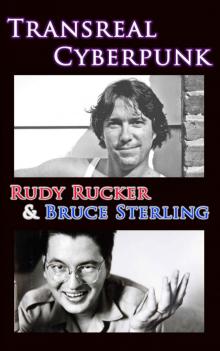 Transreal Cyberpunk
Transreal Cyberpunk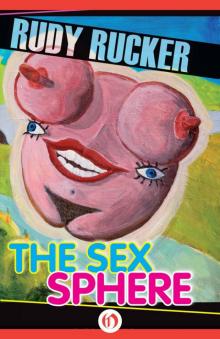 Sex Sphere
Sex Sphere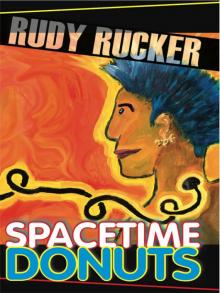 Spacetime Donuts
Spacetime Donuts Freeware
Freeware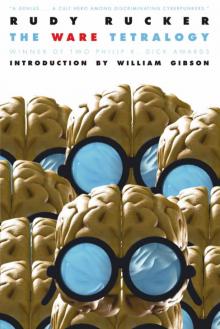 The Ware Tetralogy
The Ware Tetralogy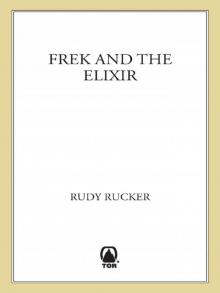 Frek and the Elixir
Frek and the Elixir Junk DNA
Junk DNA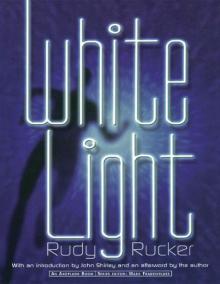 White Light (Axoplasm Books)
White Light (Axoplasm Books) Nested Scrolls
Nested Scrolls Inside Out
Inside Out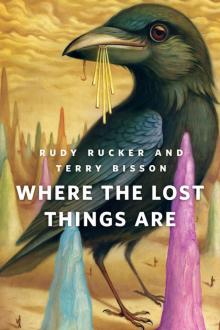 Where the Lost Things Are
Where the Lost Things Are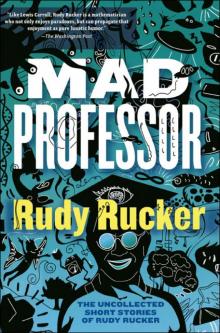 Mad Professor
Mad Professor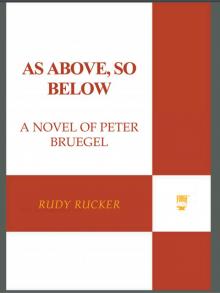 As Above, So Below
As Above, So Below Realware
Realware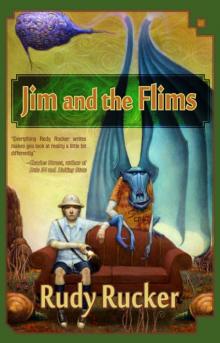 Jim and the Flims
Jim and the Flims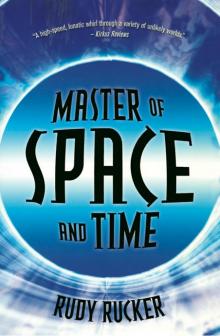 Master of Space and Time
Master of Space and Time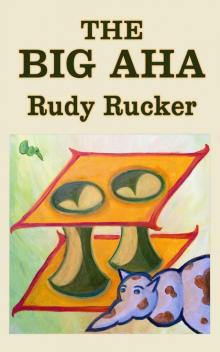 The Big Aha
The Big Aha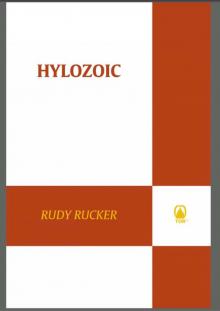 Hylozoic
Hylozoic